Johnstown is a town located in Fulton County, New York, United States. As of the 2010 census, the town had a population of 7,098. The name of the town is from landowner William Johnson. The town of Johnstown is located on the southern border of the county. It borders on three sides the city of Johnstown and the city of Gloversville.
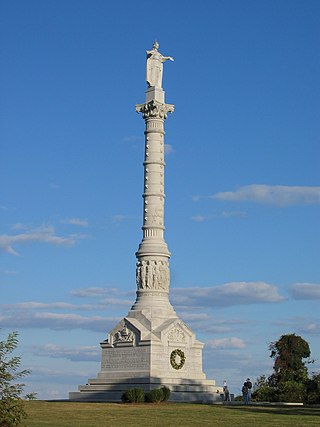
Colonial National Historical Park is a large national historical park located in the Hampton Roads region of Virginia operated by the National Park Service. It protects and interprets several sites relating to the Colony of Virginia and the history of the United States more broadly. These range from the site of the first English settlement at Jamestown, to the battlefields of Yorktown where the British Army was defeated in the American Revolutionary War. Over 3 million people visit the park each year.

This is intended to be a complete list of properties and districts listed on the National Register of Historic Places in Orleans County, New York. The locations of National Register properties and districts may be seen in a map by clicking on "Map of all coordinates". Two listings, the New York State Barge Canal and the Cobblestone Historic District, are further designated a National Historic Landmark.

The Hurley Historic District encompasses the center of the hamlet of Hurley, the main settlement area of the town of Hurley, New York. Stretched along US 209, the hamlet includes one of the finest concentrations of colonial Dutch architecture in the United States. Settled by the Dutch in the 17th century, its architecture has retained the influence of that period. The village is also historically significant as a temporary home of the seat of New York government during the American Revolutionary War. It was designated a National Historic Landmark in 1961.
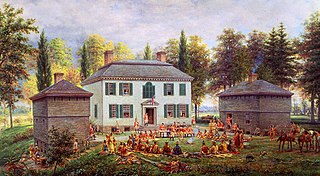
Johnson Hall State Historic Site was the home of Sir William Johnson (1715–1774) an Irish pioneer who became the influential British Superintendent of Indian Affairs in the Province of New York, known for his strong relationship especially with the Mohawk and other Iroquois League nations.

East Hampton Village District is a historic district in East Hampton, New York.

There are 75 properties listed on the National Register of Historic Places in Albany, New York, United States. Six are additionally designated as National Historic Landmarks (NHLs), the most of any city in the state after New York City. Another 14 are historic districts, for which 20 of the listings are also contributing properties. Two properties, both buildings, that had been listed in the past but have since been demolished have been delisted; one building that is also no longer extant remains listed.

St. Bridget's Roman Catholic Church Complex is a historic Roman Catholic church complex located in Bloomfield, Ontario County, New York. The complex consists of three contributing buildings and one contributing site, the church cemetery. the church is a late Victorian eclectic brick edifice with restrained Italianate and Romanesque Revival–style design and decorative features. It features a square, wood bell tower. The rectory is a 2+1⁄2-story Colonial Revival–style frame building and features a verandah with Doric order columns. A 1+1⁄2-story carriage barn stands behind the rectory. The six-acre cemetery includes burials dating from 1866 to 1942.

St. John's Episcopal Church is a historic Episcopal church at 1 North Market Street in Johnstown, Fulton County, New York. It was listed on the National Register of Historic Places in 2004.
The Kings Highway North Historic District is a predominantly residential 58-acre (23 ha) historic district in Westport, Connecticut. Located on the hillside west of the Saugatuck River, this area encapsulates architecturally several major stages in the community's development, from colonial days to the 20th century. It was listed on the National Register of Historic Places in 1998.

The Fulton County Courthouse, originally the Tryon County Courthouse, and for a time the Montgomery County Courthouse, is a historic courthouse building located on North William Street at the corner of West Main Street in Johnstown, Fulton County, New York. It was built in 1772 to 1773 and is a Late Georgian style public building. It is the oldest existing Court House in the State of New York and one of the oldest in the United States still being used as a Court House.
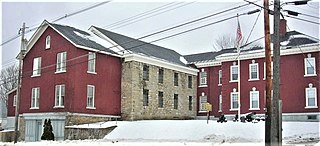
The Fulton County Jail, originally the Tryon County Jail, is a historic jail complex located at the corner of Perry and Montgomery Street in Johnstown, Fulton County, New York. The original section was built in 1772-1773 and was placed on the village's highest ground to give a defensive advantage in case of an attack by Native Americans or a war. At the time, it was thought to be one of the strongest defensive positions in colonial America, due to its placement and the thick wall, which would deflect everything but the very strongest artillery.

Douglaston Hill Historic District is a national historic district in Douglaston, Queens, New York. It includes 83 contributing buildings and two contributing sites. The buildings include Zion Episcopal Church (1830), houses and garages, and commercial buildings. The sites are Zion cemetery and public park. It was laid out with very large lots in 1853, at the very beginning of a movement in the United States to create suburban gardens. The buildings include a number of fine examples of late-19th- and early 20th-century architectural styles such as Queen Anne, Shingle Style, and Colonial Revival. The majority of the buildings date between 1890 and 1940.
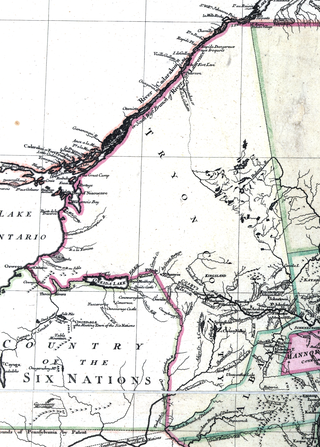
Tryon County was a county in the colonial Province of New York in the British American colonies. It was created from Albany County on March 24, 1772, and was named for William Tryon, the last provincial governor of New York. The county's boundaries extended much further than any current county. Its eastern boundary with the also-new Charlotte County ran "from the Mohawk River to the Canada line, at a point near the old village of St. Regis and passing south to the Mohawk between Schenectady and Albany." It extended north to the St. Lawrence River; its western boundary was the Treaty of Fort Stanwix's Line of Property, following the Unadilla River, Oneida Lake, Onondaga River and Oswego River to Lake Ontario, as the Iroquois Confederacy still controlled locations further west in the Indian Reserve. Tryon County's seat was Johnstown, which is today the county seat of Fulton County. The Tryon County Courthouse, built in 1772–1773, was listed on the National Register of Historic Places in 1972. The Tryon County Jail, also built in 1772–1773, was listed on the National Register of Historic Places in 1981.

The Moxham Historic District is a national historic district that is located in Johnstown in Cambria County, Pennsylvania.

Ashton Heights Historic District is a national historic district located in Arlington County, Virginia. Today, the Ashton Height Historic District contains 1,097 contributing buildings, one contributing site, and one contributing structure in a residential neighborhood in North Arlington.

Elmwood Historic District–West is a national historic district located at Buffalo, Erie County, New York. The district encompasses 1,971 contributing buildings, 4 contributing structures, and 13 contributing objects in the Elmwood Village neighborhood of Buffalo. It is built around the Buffalo Parks and Parkways system bounded on the north by Delaware Park, Forest Lawn Cemetery, and the former Buffalo State Asylum, on the south by the Allentown Historic District, and on the east by the Elmwood Historic District–East. This predominantly residential district developed between about 1867 and 1941, and includes notable examples of Queen Anne, Shingle Style, Colonial Revival, Tudor Revival, and American Craftsman style architecture. The district contains one of the most intact collections of built resources from turn of the 20th century in the city of Buffalo and western New York State. Located in the district are six previously listed contributing resources including the Richmond Avenue Methodist-Episcopal Church and the Buffalo Tennis and Squash Club. Other notable building include the H.C. Gerber House (1908), the Fred Dullard House (1910), the William H. Scott House (1904), St. John's-Grace Episcopal Church designed by Bertram Grosvenor Goodhue (1925–26), Davidson House (1885), former Jehle Grocery Store and Residence, St. Luke's Episcopal Church, Temple Beth El, Richmond Avenue Church of Christ (now Bryant Parish Condominiums, and Pilgrim-St. Luke's United Church of Christ.
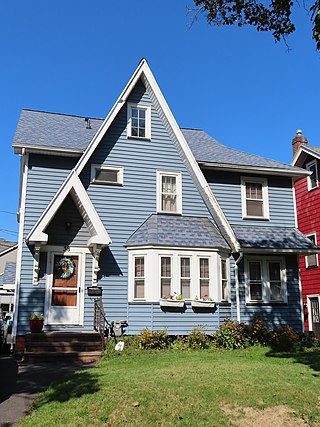
Arvine Heights Historic District is a national historic district located at Rochester, Monroe County, New York. The district encompasses 61 contributing buildings in an exclusively residential section of Rochester. The district developed between about 1920 and 1942, and includes residential buildings in a variety of architectural styles including Colonial Revival, Tudor Revival, and Bungalow / American Craftsman. The dwellings reflect modest designs directed toward a middle-class clientele in a newly developing area of Rochester's Nineteenth Ward.

Sidney Historic District is a national historic district located at Sidney, Delaware County, New York. It encompasses 906 contributing buildings, 3 contributing sites, and 3 contributing structures in the northern half of the village of Sidney. The village developed after about 1771, and includes notable examples of Greek Revival, Gothic Revival, Italianate, Queen Anne, Colonial Revival, and Bungalow architecture. Located in the district is the separately listed Pioneer Cemetery. Other notable contributing resources are the Johnston-Clum House (1798), Spencer Block, Fairbanks Building, Elks Lodge #2175, Sidney High School (1929), municipal building (1909), Sidney Memorial Library, MacDonald Hose Company (1943), First Congregational Church (1808), United Methodist Church (1931), Smith-Cable house (1808), Ezra Clark house, and Prospect Hill Cemetery. The district also includes one especially well-documented multi-component archeological site representing the period 850 BC-1400 AD.
Elmwood Historic District–East is a national historic district located at Buffalo, Erie County, New York. The district encompasses 2,405 contributing buildings, 31 contributing structures, and 14 contributing objects in the Elmwood Village neighborhood of Buffalo. It is bounded on the north by Delaware Park, Forest Lawn Cemetery, and the former Buffalo State Asylum, on the south by the Allentown Historic District, and on the west by the Elmwood Historic District–West. This predominantly residential district developed between about 1867 and 1965, and includes notable examples of Queen Anne, Shingle Style, Colonial Revival, Tudor Revival, and American Craftsman style architecture. The district contains one of the most intact collections of built resources from turn of the 20th century in the city of Buffalo and western New York State. Located in the district are 17 previously listed contributing resources including the Buffalo Seminary, Garret Club, James and Fanny How House, Edgar W. Howell House, Edwin M. and Emily S. Johnston House, Col. William Kelly House, Lafayette Avenue Presbyterian Church, Parke Apartments, and the Unitarian Universalist Church of Buffalo. Other notable building include the Frank Lloyd Wright designed William R. Heath House (1904-1905), Herbert H. Hewitt House, School 56 (1910-1911), the Harlow House, A. Conger Goodyear house, Alexander Main Curtiss House, Nardin Academy campus, and Coatsworth House (1897).





















